![]()
![]()
![]()
Use LEFT and RIGHT arrow keys to navigate between flashcards;
Use UP and DOWN arrow keys to flip the card;
H to show hint;
A reads text to speech;
16 Cards in this Set
- Front
- Back
- 3rd side (hint)
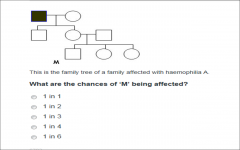
=
|
1 in 2
info+ |
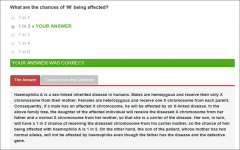
|
|
|
Genetic Mosaicism:
is defined as a condition in which cells with different = |
genotypes
or chromosome constitutions are present in the same individual. i |
It is random: in some cells of the female embryo, the X chromosome inherited from the father is inactivated,
and in others the X chromosome inherited from the mother is inactivated. Like coin tossing, this is a random process. Most women have their paternal X chromosome active in approximately 50% of their cells and the maternal X chromosome active in approximately 50% of their cells. Thus, females are said to be mosaics with respect to the active X chromosome. |
|
|
Mechanisms Associated with
X Inactivation: X-chromosome inactivation is thought to be mediated by more than one mechanism. |
A gene called XlST =
has been identified as the primary gene that causes X inactivation. XIST produces an RNA product that coats the chromosome, helping produce its inactivation. |
(X-inactive specific transcript)
Condensation into heterochromatin ►Methylation of gene regions on the X chromosome |
|
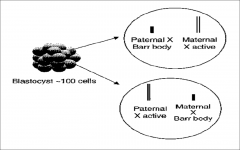
X-Linked Dominant Inheritance
There are relatively few diseases whose inheritance is classified as X-linked dominant. an important example = |
Fragile X syndrome
females are differently affected than males, and whereas penetrance in males is __ %, in females is approximately __ % The typical fragile X patient is which sex = |
100
60 60 As in X-linked recessive inheritance, male-male transmission of the disease-causing mutation is not seen |
|
|
Penetrance in Genetic Diseases:
*** |
a disease-causing mutation is the percentage of individuals who are known to have the disease-causing genotype .
who display the disease phenotype (develop symptoms). p |
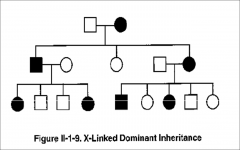
|
|
|
Recurrence Risks:
Affected male-homozygous normal female: None of the all of the = |
sons are affected;
daughters are affected. |
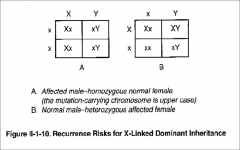
|
|
|
X-linked Dominant Diseases:
3ct |
Hypophosphatemic rickets
Fragile X syndrome Alports’s syndrome |
|
|
|
Hypophosphatemic rickets
is *** caused by a mutation in the = |
fibroblast growth factor # =
Hypophosphatemic rickets affects men and women _______ ; symptoms may become apparent at any point from |
23 (FGF23).
equally childhood through early adulthood. |
|
|
*** Rickets is a disorder caused by = 3ct
|
a lack of:
-vitamin D, -calcium, -phosphate |
|
|
|
*** Rickets
▼phosphate (hypophosphatemia) S. calcium = High urinary = Inappropriately normal levels of = X-ray: Cupped metaphysis with widening of epiphysis Treatment consists of increasing phosphate intake and high doses of vitamin D. |
N, Alkaline phosphatase ▲
po4 vitamin D. |
|
|
|
Fragile X syndrome
Type of Mutation = |
X-Linked Dominate***
Males: __ % penetrance Females: __ % penetrance |
100
60 Mental retardation Large ears Prominent jaw Macro-orchidism (usually postpubertal) |
|
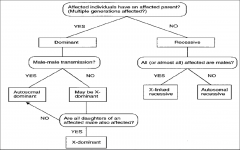
Mitochondrial Inheritance
Mitochondria, which are cytoplasmic organelles involved in cellular respiration, have their own chromosomes, each of which contains 16,569 DNA base pairs (bp) arranged in a circular molecule. |
This DNA encodes 13 proteins that are subunits of complexes in the electron transport and oxidative phosphorylation processes .
In addition, mitochondrial DNA encodes 22 transfer RNAs and 2 = |
ribosomal RNAs
|
|
|
Because a sperm cell contributes no mitochondria to the egg during fertilization,
mitochondrial DNA is inherited exclusively through =. |
females
Pedigrees for mitochondrial diseases thus display a distinct mode of inheritance: Diseases are, transmitted only from affected = |

females to their offspring.
Both males and females are affected. Transmission of the disease is only from a female. All offspring of an affected female are affected. None of the offspring of an affected male is affected. Diseases are typically neuropathies and/or myopathies |
|

|
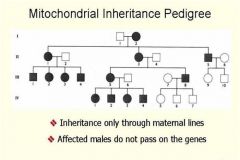
|
|
|
|
Heteroplasmy
A typical cell contains hundreds of mitochondria in its cytoplasm. Sometimes a specific mutation is seen in only some of the mitochondria, a condition known as =. |

Heteroplasmy
Variations in heteroplasmy can result in substantial variation in the severity of expression of mitochondrial diseases. |
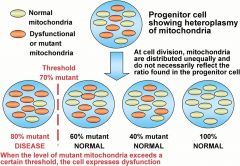
|
|
|
Mitochondrial Diseases:
5ct h+ |
-Kearns-sayre syndrome
-Leber’s hereditary optic neuropathy -MELAS: mitochondrial encephalomyopathy, lactic acidosis w stroke-like episodes -(MERRF syndrome) Myoclonic epilepsy w ragged red myo fibers -Sensory neural hearing loss (Mitochondrial) |
K
L M M S |

